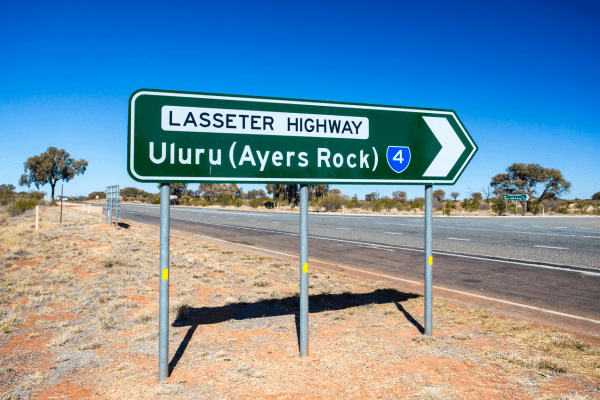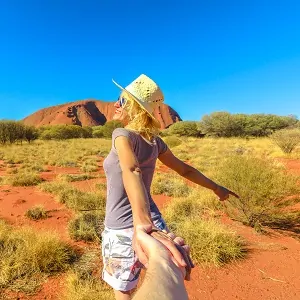Get to know the incredible Uluru with these 11 interesting facts about the monolith!
- Get to know the incredible Uluru with these 11 interesting facts about the monolith!
- 1. Uluru is taller than the Eiffel Tower
- 2. It takes about 3.5 hours to walk around the base of Uluru
- 3. There is even more of Uluru underground
- 4. Traditional owners own the Uluru-Kata Tjuta National Park
- 5. That’s why Uluru has two names
- 6. It also has two UNESCO World Heritage listings
- 7. Aboriginal people have called the area home for at least 30,000 years
- 8. Uluru receives around 300mm of rainfall every year
- 9. Uluru is home to a surprising amount of plants and wildlife
- 10. Climbing Uluru is prohibited
- 11. But Prince Charles and Princess Diana still climbed it
- Explore the Uluru Tours!
Uluru, in Australia’s Red Centre, is a bucket list item for many international travellers and locals alike. It’s no wonder, as it is one of the most easily recognized landmarks in Australia. Get to know this impressive rock formation before your trip to the Red Centre, with these incredible facts!
1. Uluru is taller than the Eiffel Tower
Towering 348 metres above the surrounding plane, Uluru is taller than several famous buildings around the world. It’s even taller than the Eiffel Tower in Paris, the Chrysler Building in New York, and the Great Pyramid of Giza.
2. It takes about 3.5 hours to walk around the base of Uluru
Uluru is 3.6 km long and 1.9 km wide, with a total circumference of 9.4 km. The incredible walk around the base takes you through a surprising variety of landscapes. The hike is best attempted in the morning before the desert heat sets in.
3. There is even more of Uluru underground
Uluru is big, but most of its mass is actually buried under the surrounding desert. Uluru as we see it today was created by millions of years of erosion of the softer surrounding rock. Beneath the surface, Uluru extends at least another 2.5 km.
4. Traditional owners own the Uluru-Kata Tjuta National Park
The local Anangu people were recognised as the traditional owners in 1985. They now lease the land to the Australian government. They also work in partnership with Parks Australia to manage and maintain the area.
5. That’s why Uluru has two names
William Gosse was the first European to set eyes on Uluru in 1873. He named it Ayers Rock after the Chief Secretary of South Australia at the time. In 1993, the name was changed to Ayers Rock / Uluru, acknowledging the given Aboriginal name. Then in 2002, the names were switched around to prioritise the Aboriginal name. These days, while the monolith is called Uluru / Ayers Rock, most people call it Uluru.
6. It also has two UNESCO World Heritage listings
In 1987, Uluru was added to the UNESCO World Heritage List for its unique geology. A few years later in 1994, the rock’s cultural significance to the Aboriginal people was also recognised.
There are over 1,000 UNESCO World Heritage sites, and less than 50 listings have made the list for both cultural and natural significance.
7. Aboriginal people have called the area home for at least 30,000 years
Archaeological evidence has been found to suggest that Aboriginal people have inhabited the area around Uluru for over 30,000 years. You can view rock art on a walk around the base of Uluru, including paintings that date back 5,000 years.
Uluru is a significant site for the local Anangu people. Because of this, there are a few sacred locations around the rock where taking photos and videos are prohibited.
8. Uluru receives around 300mm of rainfall every year
It varies from year to year, but Uluru receives around 300mm of rain on average each year. The rain creates waterfalls and brings new life to the rock and surrounding desert.
Heavy rain typically occurs from November to March, but it can rain any time of the year. The wettest month in Uluru is often in January. Between October and February, there can also be lightning storms with strong winds.
9. Uluru is home to a surprising amount of plants and wildlife
Uluru and the surrounding area hosts over 400 plant species. Much of the flora has traditional uses in Anangu culture as food, medicine and tools. Many animals also call the area home. This includes 21 species of mammals such as dingoes, red kangaroos and the spinifex hopping mouse.
10. Climbing Uluru is prohibited
The Anangu people always requested that visitors refrain from climbing the rock out of respect for their ancient culture. Climbing to the summit was officially banned in October of 2019. After that, the chain guide that was fastened to the rock was permanently removed.
11. But Prince Charles and Princess Diana still climbed it
The royals climbed Uluru on their 1983 tour of Australia when visiting the Red Centre.
Related article: When is the best time to visit Uluru?
Explore the Uluru Tours!
-
8 Day Uluru to Adelaide Tour
Destination: Northern Territory
Duration: 8 Days
Tour type: Overland Tour
Available Now
From $1995
-
3 Day Uluru & Kings Canyon Premium Camping Tour
Destination: Alice Springs
Duration: 3 Days
Tour type: Short Break Tour
Available Now
From $780
-
3 Day Uluru & Kings Canyon Tour from Alice Springs to Alice Springs
Destination: Alice Springs
Duration: 3 Days
Tour type: Short Break Tour
Available Now
From $679
-
3 Day Uluru & Kings Canyon Tour from Uluru to Alice Springs
Destination: Northern Territory
Duration: 3 Days
Tour type: Short Break Tour
Available Now
From $679











